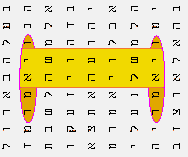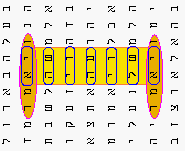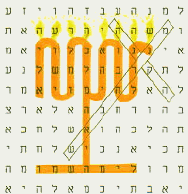Yeshua Bible Code
found at the Burning-Bush Passage
Part 4
This self-interpretation makes use of
complex acrostics as word dividers!
As said, reading around in a circle, the bible code reads:
They cried out for help in the direction of a (mountain) summit:
"Let Him be changed into a man!"
Lo, They cried out for help!
The Gift of God will become that man!
A triple acrostic is formed from the first letter of each word, and from the first letter of each sentence, and from the words of the acrostic itself!
The first letter of each Hebrew sentence spells, "The Lord," (i.e., "Jah").
The first letter of each of the three acrostic words spell: "He will become!" (The root for this word, "to be," is related to the word "Jehovah.")
The first letter of each Hebrew word (of the above main code) spells:
"He will cause to loosen." And,
"Will the Lord bear guilt?" (Or, "Will the Lord pardon?" Or, "Will the Lord be lifted up," [Yeshua was "lifted up" on the cross, and then exalted to Glory]. Or, "Will the Lord give away in marriage?" Recall, "He will be joined;" the bible code is ultimately about His marriage to the Church, [Revelation 19:9]. But, this will be studied later in the bible code.
But what does, "He will cause to loosen," mean?
This has been answered already in the discussion, "The words where the bible code lands during its 120-letter skips." Keep in mind that that document was written before I knew anything of what is in this page.
The 600th letter down from the top of the bible code (120 x 5 letters = 600), is the word: "Loose!" And it is the same root word found in the acrostic. The word "loose!" here, is part of the actual text in Exodus that reads:
"And he said, Draw not nigh hither: loose thy shoes from off thy feet, for the place whereon thou standest is holy ground," (Ex. 3:5).
I will not take the time here to repeat what I have already said elsewhere, but let me quote this one passage of Scripture that will lead into the next part of this study:
"And I saw in the right hand of him that sat on the throne a book written within and on the backside, sealed with seven seals. And I saw a strong angel proclaiming with a loud voice, Who is worthy to open the book, and to loose the seals thereof?
And no man in heaven, nor in earth, neither under the earth, was able to open the book, neither to look thereon. And I wept much, because no man was found worthy to open and to read the book, neither to look thereon. And one of the elders saith unto me, Weep not: behold, the Lion of the tribe of Juda, the Root of David, hath prevailed to open the book, and to loose the seven seals thereof," (Revelation 5:1-5).
Note the symbolic description of the One who is found worthy to open the Scroll:
"And I beheld, and, lo, in the midst of the throne and of the four beasts, and in the midst of the elders, stood a Lamb as it had been slain, having seven horns and seven eyes, which are the seven Spirits of God sent forth into all the earth," (Revelation 5:6).
Only the Lamb, who has "borne the guilt" of man, is worthy to "loosen" the seven seals!
Acrostics as word dividers are nowhere!
"Acrostics are nowhere!" How would you divided this last word "nowhere'? Should it read, "Acrostics are no where!" Or, "Acrostics are now here!" As you can see, where you divide the word can make a great deal of difference! And this is the same problem with the bible codes. They do not come with word dividers.
Word dividers mark where one word ends off and another word begins. However, instead of empty spaces between words, there is another, more ingenious, method. Acrostics! Acrostics, can tell us where one word ends off and another begins! Many bible codes use this method, but not all. When used, their purpose seems to be either to avoid ambiguity, or to add emphasis, (i.e., by repeating its parent message.) In the case of this bible code, it appears to be for the latter reason.
However, the message from this acrostic adds emphasis, not merely to its parent message, but it also draws attention to its very methodology as well. This particular acrostic is not just unsealing the bible code for us by telling us where the unbroken line of letters join as words, but, the very message of the acrostic speaks of the same; namely, that the risen Lamb alone is worthy to unseal (loosen) the Scroll. Hence, both the acrostic's methodology and its message agree as one---the unsealing of the Scroll. What the acrostic says, it also does!
Ponder again what the acrostic says, and does:
"He will cause to loosen." And,
"Will the Lord bear guilt?" Recall that it is the sin bearing Lamb that loosens the Scroll, (Revelation 5:6).
Click here to continue to "Part 5", and see how the picture bible code of the Scroll is superimposed over this picture bible code of the menorah, and to find out what the 'handles' of the Scroll say!
The DNA/Scroll Series
The four names at the bush code
The Bible Code is self-interpreted! ( by going around the bible code!)
This self-interpretation makes use of complex acrostics as word dividers!
Bible-Code picture of "The Scroll-of-the-Lamb" emerges, beside the seven-branched menorah!
"I AM that I AM," as self-interpreted by this bible prophecy code at the burning bush!
The following expands upon this same code:
See
also the Menorah (Lamp) at the burning Mountain that continues and compliments the above code. In the bible, all three pictures---the scroll, the mountain, and the menorah, are used as symbols of divine revelation. They are the 'what' (scroll), 'where' (mountain), and 'how' (light of the Lamp), of divine revelation.




